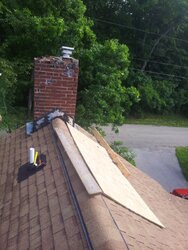I bought this wood stove about 18 months ago. I have a 10 foot up 6" stovepipe, which then does a 90 degree turn into the wall for about 2 ft where it enters a vertical unlined and uncapped 100 year old chimney. The stovepipe and chimney were cleaned by me this fall, and cleaned by a chimney sweep last week.
The stove worked great last winter, but about a month into using it this season, we started getting smoke leaking from the bend of the stove pipe and from where the pipe meets the wall. Hence the incredibly expensive chimney sweep visit - he diagnosed that we need the stove pipe to go all the way to the top of the chimney and have a cap.
BUT since his visit, it's INCREDIBLY hard to get a fire going at all. Our solution to smoke leaking was to run a very hot fire, which fixed the issue. Now I can't even get the fire to go with the damper fully out, unless the door is open, in which case smoke billows into my living room. As soon as I close the door, the fire goes out. I have cleaned the stove as best I can, getting into all the nooks and crannies, but I just cannot seem to get it going. The chimney sweep says it's just coincidence that this issue started the day he was here and refuses to come back. I have the guys who installed the stovepipe coming after Christmas, but they say they won't look at the stove itself, which I bought from Home Depot, because it was not bought from them. They are the only people who do wood stove stuff in my small rural town.
Help? What should I try next? I have bought some sealer for the stove pipe, but if drawing is the issue, then it will only exacerbate the issue in the stove itself I think?
The stove worked great last winter, but about a month into using it this season, we started getting smoke leaking from the bend of the stove pipe and from where the pipe meets the wall. Hence the incredibly expensive chimney sweep visit - he diagnosed that we need the stove pipe to go all the way to the top of the chimney and have a cap.
BUT since his visit, it's INCREDIBLY hard to get a fire going at all. Our solution to smoke leaking was to run a very hot fire, which fixed the issue. Now I can't even get the fire to go with the damper fully out, unless the door is open, in which case smoke billows into my living room. As soon as I close the door, the fire goes out. I have cleaned the stove as best I can, getting into all the nooks and crannies, but I just cannot seem to get it going. The chimney sweep says it's just coincidence that this issue started the day he was here and refuses to come back. I have the guys who installed the stovepipe coming after Christmas, but they say they won't look at the stove itself, which I bought from Home Depot, because it was not bought from them. They are the only people who do wood stove stuff in my small rural town.
Help? What should I try next? I have bought some sealer for the stove pipe, but if drawing is the issue, then it will only exacerbate the issue in the stove itself I think?


 .... lots of stuff could be plugging up the works.
.... lots of stuff could be plugging up the works.